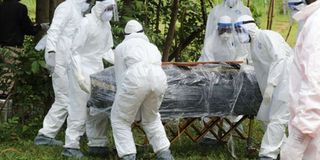How to bury someone who died of Covid-19

A Covid-19 vicitim is buried in Western Kenya. FILE PHOTO | NATION MEDIA GROUP
What you need to know:
- In the event that a Covid-19 related death occurs at home or within the community, guidelines issued by the Ministry of Health require that family members immediately notifies the nearest health service delivery point such as a hospital.
As the Covid-19 pandemic bites, some families are facing a new challenge of properly burying their loved ones who have succumbed to the disease.
Although the death rate in the Kenya is much lower as compared to other African countries such as South Africa, there is need for caution in burying victims in a decent manner while minimising the risk of spread the virus.
Here are some of the procedures you need to know if you are burying a loved one who has died from Covid-19.
Once death occurs
Most Covid-19 deaths that have been reported have occurred at hospitals, where the patient suffering from the disease was admitted and later succumbed from complications such as difficulties breathing. If this occurs, the hospital will initiate its protocols in handling of the body in preparation for burial.
However, in the event that a Covid-19 related death occurs at home or within the community, guidelines issued by the Ministry of Health (MOH) require that family members immediately notifies the nearest health service delivery point such as a hospital.
The health service delivery point will then notify the county disease surveillance department within the facility and county office which is then relayed to the Ministry of Health disaster emergency response operation centre.
The county surveillance department will notify the regional pathologist, who is responsible for supervision and guidance in ensuring the body is handled safely and promptly.
When death is confirmed by the relevant health care providers, MOH recommends that the bodies should be immediately tagged then placed into leak proof and tamper proof body bags.
Preparing the body for burial
As per regulations issued by MOH, the health worker at the hospital or mortuary must ensure that the body is handled applying strict standard precautions, including hand hygiene before and after interaction with the body and the environment.
The health worker also needs to adhere to the use of appropriate personal protective equipment (PPE) at all times place the body into leak proof and tamper proof body bags. If there is risk of splashes from the body fluids or secretions, MOH recommends that personnel should use facial protection, including the use of face shield or goggles and medical mask.
These are some of the additional precautionary regulations that MOH has given to health workers handling the body:
All the bodies confirmed to be positive for the coronavirus must be immediately placed in a designated isolate refrigerated chamber with a temperature of between 2-4 degrees centigrade.
Health workers should keep both the movement and handling of the body to a minimum.
The body should also be labelled and bagged/plastic wrapped immediately into a body bag, which should be made of PVC, leak proof and tamper proof material.
Bodies should also be double bagged and once wrapped, it must not be opened thereafter.
The outermost body bag must be wiped with 0.5 percent sodium hypochlorite/disinfectant.
There should be no embalming to avoid excessive manipulation of the body.
At the Mortuary
The Ministry of Health also issued a number of guidelines for family members coming to view and collect the body of their loved one who died from Covid-19 for burial. These guidelines are to ensure that the virus does not spread from the deceased to other people.
According to the Centres for Disease Control and Prevention (CDC), it may be possible for an individual to contract Covid-19 by touching the body of someone who has died of the disease.
These are the guidelines that MOH issued for the burial of persons who died from Covid-19:
The body must be disposed of or buried by the family as soon as possible (within 48 hours) under supervision of the healthcare personnel, the local Health care committee leader and religious leader.
Once the body has been delivered to the mortuary, the casket must be cleaned and disinfected using the standard procedures.
The body should not be reopened for viewing once it is put into the casket.
The vehicle used to deliver the body should be cleaned and before it leaves the mortuary after it has handed the body to the morgue.
Family members should ensure they coordinate all transportation of the deceased person with coronavirus disease with the local health officials
At the Funeral
These are the guidelines that the MOH has issued for burial ceremonies:
The burial should be overseen by a public health official to avoid community practices that would result in more infections through contact.
The health worker must ensure that the casket is handled using the PPE, including single-use (disposable) gloves with extended cuffs and double gloving, at all times.
The body of the deceased should be buried within the same day it left the mortuary.
There should be no social or religious gathering at the funeral, meaning that the number of persons should be limited to only 15 persons.
Social distancing and other Covid-19 prevention protocols should also be observed.
Persons above the age of 60 years as well as those with weakened immune systems should not directly interact with the body.
Relatives are strictly forbidden from touching or kissing the body as well as other unnecessary contact with the body or casket.
Once the burial is done, health officials should fumigate the site of burial, transportation vehicle and other sites in contact using 10 percent formaldehyde.





